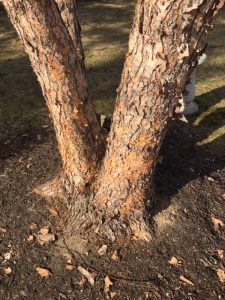What caused a river birch tree to drop bark?
Question:
My river birch is dropping deep segments of bark from the ground up to about three feet. It is not the normal sloughing off of the outer layer. What is coming off leaves bare wood underneath. Could this be a vole or a disease? I sprayed the base of tree with a hot pepper spray hoping to discourage a vole.

Answer:
I have run the pictures you sent through our team and have some feedback for you.
First, the good news is that your river birch does not appear to be in poor health overall–structure, color, and wood are good. The black spots may be a separate fungal issue, but we would need to talk you through submitting a pathology sample to confirm for certain. I don’t think it’s related to the bark loss lower down.
Second, there are a couple of potential reasons for the bark loss at the base. The health of the tree and the relatively localized area being impacted make me think either an animal browsing (you mentioned voles in your email, but deer and raccoon are also potential culprits) or environmental damage (either weather related, meaning simply a heavier bark loss than normal, or possibly a mower or snowblower in close proximity). We suggest cleaning up the bark piles and then watching closely to see how long it takes for the bark to accumulate. If they reappear pretty fast, browsing looks more likely, in which case a physical barrier might be in order to prevent further damage while the tree heals. As long as the bark loss isn’t deep enough to reach the tree’s phloem, or widespread enough to girdle the tree, your birch should recover.
Another suggestion is to examine the base closely to look for holes (especially D-shaped ones) that might reveal the presence of borers. Fortunately, river birch is pretty resistant to the pest, but it’s worth taking a closer look to see.
One quick follow suggestion that came in from a wildlife biologist we consulted–you might check the tree base for scratches from claws (indicating climbing) or feeding damage from a mammal.
